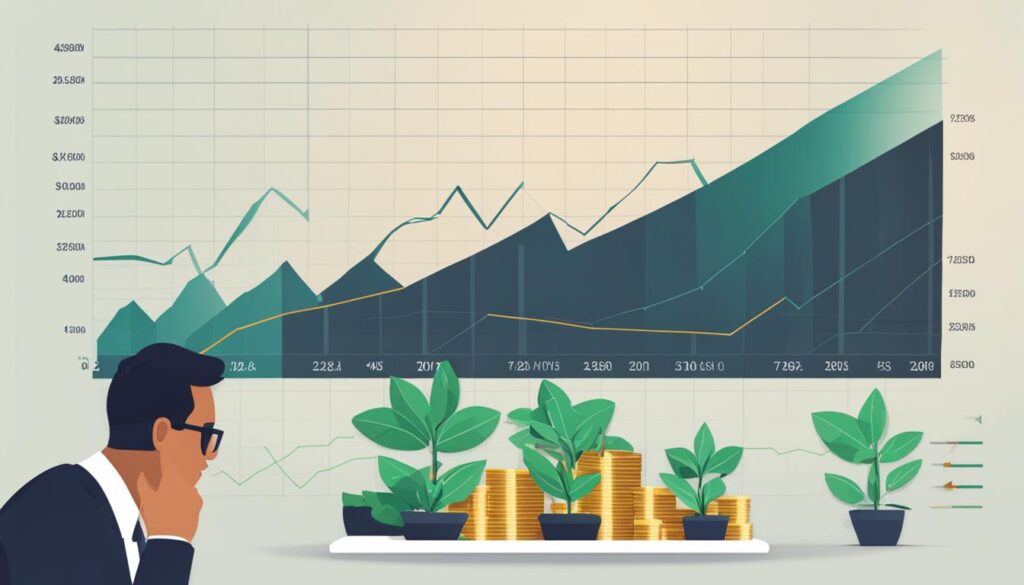Inflation can have a significant impact on your finances, eroding the purchasing power of your savings and investments over time. It is essential to track inflation and its effects to protect your financial well-being. The Inflation Indexer offers a solution for monitoring and managing the impact of inflation on your finances. By understanding the factors that contribute to inflation and implementing effective strategies, you can safeguard your purchasing power and maintain control over your financial future.
Key Takeaways:
- Monitor and track the impact of inflation on your finances for effective financial planning.
- Understand the causes and effects of inflation to make informed decisions.
- Consider inflation-adjusted investment options like Treasury Inflation-Protected Securities (TIPS) and stocks to protect your purchasing power.
- Regularly review and adjust your financial strategies to mitigate the erosion of purchasing power caused by inflation.
- Protect your retirement income by considering the impact of inflation on Social Security benefits and exploring additional strategies.
Understanding Inflation and Its Effects
Inflation, the gradual increase in the price of goods and services over time, can have a significant impact on consumer prices and spending power. As prices rise, the purchasing power of our money decreases, making it more challenging to afford the same amount of goods and services. It’s essential to understand how inflation works and its effects on our finances.
One of the key concepts in managing inflation is the need for inflation adjustment. Without adjusting for inflation, our savings and income may not keep up with rising costs, leading to a loss of spending power and a lower standard of living. To mitigate these effects, it’s crucial to implement strategies that protect our purchasing power.
By understanding the causes and effects of inflation, we can make informed decisions to navigate its impact on our finances. Whether it’s through adjusting our budget, exploring investment options that outpace inflation, or considering inflation-adjusted returns on our savings, being proactive in managing inflation can help us maintain control over our financial future.
Understanding Inflation’s Impact
When inflation occurs, the prices of goods and services rise, eroding the value of our money. This decrease in purchasing power means that the same amount of money can buy fewer goods and services over time. For example, if the inflation rate is 2% per year, the purchasing power of $100 in one year would only be worth $98. Inflation can impact various aspects of our financial lives, including savings, investments, and retirement planning.
Consumer Price Index (CPI)
The Consumer Price Index (CPI) is a commonly used measure to track changes in consumer prices over time. It gauges the average price change of a basket of goods and services purchased by households. By monitoring the CPI, we can better understand how inflation affects the cost of living and make necessary adjustments to our financial plans.
Inflation Adjustment Strategies
There are several strategies we can employ to mitigate the impact of inflation on our finances. One approach is to invest in assets that historically outpace inflation, such as stocks or precious metals. Additionally, exploring investment options like Treasury Inflation-Protected Securities (TIPS) that offer inflation-adjusted returns can help safeguard our savings against inflationary pressures. By diversifying our investment portfolio and staying informed about inflation metrics, we can protect our purchasing power and achieve our financial goals.
The Importance of Inflation Management
Inflation management is crucial for safeguarding the value of your savings and investments. As inflation erodes the purchasing power of your money over time, it is essential to implement strategies that mitigate its impact and preserve your financial well-being. By diversifying your investment portfolio and considering various inflation management options, you can offset the effects of inflation and maintain control over your financial future.
Treasury Inflation-Protected Securities (TIPS)
Treasury Inflation-Protected Securities (TIPS) are government-issued bonds that offer inflation-adjusted returns. These securities provide protection against rising consumer prices by adjusting the principal value of the bond based on changes in the Consumer Price Index (CPI). By investing in TIPS, you can ensure that your savings keep pace with inflation, preserving your purchasing power.
Government I bonds
Government I bonds are another investment option that helps combat the effects of inflation. These bonds are backed by the U.S. government and provide a fixed rate of return that is adjusted for inflation. By holding government I bonds, you can protect your savings from the eroding effects of rising consumer prices.
Stocks and precious metals
Stocks and precious metals, such as gold and silver, have historically outpaced inflation and provided potential growth. Investing in stocks allows you to participate in the growth of companies that can generate returns that outpace inflation over the long term. Precious metals are often seen as a hedge against inflation, as their value tends to rise when the purchasing power of currency declines. Including stocks and precious metals in your investment portfolio can help you maintain or even grow your wealth despite inflationary pressures.
| Investment Option | Inflation Protection | Potential Returns |
|---|---|---|
| Treasury Inflation-Protected Securities (TIPS) | Adjusts for inflation | Lower returns, but preserves purchasing power |
| Government I bonds | Adjusts for inflation | Lower returns, but preserves purchasing power |
| Stocks | Historically outpace inflation | Potential for higher returns |
| Precious metals | Considered a hedge against inflation | Potential for higher returns |
By diversifying your investments and considering options like TIPS, government I bonds, stocks, and precious metals, you can effectively manage inflation and protect the value of your savings and investments. Consult with a financial advisor to determine the best strategies that align with your financial goals and risk tolerance.
The Impact of Inflation on Savings
Inflation can significantly impact your savings. It is crucial to understand how inflation rates and interest rates on savings accounts can affect the real value of your savings over time. Failure to account for inflation can result in a loss of wealth and hinder your financial goals. Here, we explore the relationship between inflation, interest rates, and savings, and provide strategies to mitigate the impact of inflation on your savings.
The Impact of Inflation Rate
The inflation rate refers to the percentage increase in the prices of goods and services over time. If the inflation rate exceeds the interest earned on your savings account, the real value of your savings will decrease. Let’s consider an example: if you have $10,000 in a savings account with a 1% interest rate, and the inflation rate is 2%, the purchasing power of your savings will decrease by $100 over a year.
It is important to choose savings accounts with interest rates that outpace inflation to maintain the value of your savings. High-yield savings accounts or certificates of deposit (CDs) with competitive interest rates can help offset the negative impact of inflation on your savings. By regularly comparing interest rates offered by different financial institutions, you can find accounts that provide a higher return on your savings and protect your purchasing power.
Strategies to Combat Inflation
There are various strategies you can employ to combat the impact of inflation on your savings:
- Invest in assets that outpace inflation: Consider investing in assets such as stocks or real estate that historically offer higher returns than the inflation rate. These investments have the potential to grow your wealth and preserve your purchasing power over time.
- Diversify your investment portfolio: By diversifying your investments across different asset classes, you can spread the risk and potentially offset any losses caused by inflation in one area with gains in another.
- Consider inflation-linked bonds: Inflation-indexed bonds, such as Treasury Inflation-Protected Securities (TIPS), provide investors with returns that are adjusted for inflation. These bonds can help protect the value of your savings from eroding due to inflation.
By implementing these strategies and staying informed about the current inflation rate, you can better manage the impact of inflation on your savings and achieve your long-term financial goals.

| Year | Inflation Rate | Interest Rate | Real Value of Savings |
|---|---|---|---|
| 2020 | 2% | 1% | $10,000 |
| 2021 | 3% | 1% | $9,800 |
| 2022 | 2.5% | 1% | $9,607 |
Measuring and Monitoring Inflation
Measuring and monitoring inflation is essential for understanding its impact on the economy and your personal finances. Two widely used indices for tracking inflation in the United States are the Consumer Price Index (CPI) and the Producer Price Index (PPI). The CPI measures the changes in prices of a basket of goods and services typically purchased by urban consumers, providing insights into changes in purchasing power over time.
The PPI, on the other hand, focuses on tracking changes in prices at the wholesale level. It measures the average change in selling prices received by domestic producers of goods and services, offering a different perspective on inflationary trends. Both indices are important tools for economists, policymakers, and individuals to understand and respond to inflationary pressures.
Understanding the CPI and the PPI can help you make informed financial decisions. By keeping a close eye on these indices, you can anticipate changes in prices, adjust your spending, and consider investment strategies that can help preserve your purchasing power. For instance, if the CPI shows a significant increase in housing costs, you may want to explore ways to reduce your housing expenses or consider investing in real estate to capitalize on the rising prices.

Additionally, monitoring inflation helps you stay ahead of potential wage stagnation. If prices are rising faster than your income, it may be necessary to negotiate for higher wages or seek alternative income-generating opportunities. Being aware of inflationary trends empowers you to take proactive steps to protect your financial well-being.
Consumer Price Index (CPI) vs. Producer Price Index (PPI)
| Consumer Price Index (CPI) | Producer Price Index (PPI) | |
|---|---|---|
| Definition | The CPI measures changes in prices of goods and services purchased by urban consumers. | The PPI measures changes in prices received by domestic producers of goods and services. |
| Focus | Tracks changes in consumer prices. | Tracks changes in wholesale prices at the producer level. |
| Components | Includes a wide range of goods and services such as housing, transportation, food, and healthcare. | Includes prices of goods and services at various stages of production, such as crude materials, intermediate goods, and finished goods. |
| Use | Provides insights into changes in purchasing power for consumers. | Offers a perspective on inflationary pressures faced by producers. |
“Understanding inflation indices like the CPI and the PPI can help individuals and businesses make informed financial decisions.”
By staying informed about inflation metrics, individuals and businesses can adapt their financial strategies accordingly. Whether it’s adjusting spending habits, negotiating for higher wages, or exploring investment options, measuring and monitoring inflation is a critical step in navigating the ever-changing economic landscape.
Inflation and Social Security
Inflation has a direct impact on Social Security benefits. The Cost of Living Adjustment (COLA) annually increases Social Security payments based on the measured inflation rate. However, there is ongoing debate about whether the COLA adequately reflects the true cost of living for retirees, particularly regarding rising healthcare expenses. Retirees relying on Social Security must consider the impact of inflation on their benefits and explore additional strategies to protect their purchasing power throughout retirement.
“The COLA is a critical factor in determining the purchasing power of Social Security benefits,” says financial analyst Jane Johnson. “However, it’s important to recognize that the inflation rate used to calculate the COLA may not align perfectly with retirees’ actual expenses. Healthcare costs, for example, have been rising faster than the overall inflation rate, leaving many retirees struggling to cover medical expenses.”
Retirees can take proactive steps to mitigate the impact of inflation on their Social Security benefits. One strategy is to maximize retirement savings by investing in assets that historically outpace inflation, such as stocks or real estate. Additionally, exploring supplemental income options, such as part-time work or rental income, can provide a buffer against rising living expenses.
It’s also important to create a comprehensive retirement budget that accounts for inflation. By factoring in rising costs for healthcare, housing, and other essential expenses, retirees can better plan for the long-term and ensure their Social Security benefits align with their financial needs.

Table: Impact of Inflation on Social Security Benefits
| Year | Inflation Rate | COLA Adjustment | Real Increase/Decrease in Benefits |
|---|---|---|---|
| 2020 | 2.3% | 1.6% | -0.7% |
| 2019 | 1.6% | 2.8% | 1.2% |
| 2018 | 2.1% | 2.0% | -0.1% |
Table: The table above illustrates the impact of inflation on Social Security benefits in recent years. In 2020, despite an inflation rate of 2.3%, the COLA adjustment was only 1.6%, resulting in a decrease in real benefits. Conversely, in 2019, the 1.6% inflation rate led to a 2.8% COLA adjustment, resulting in a real increase in benefits for retirees. It’s important for retirees to closely monitor COLA adjustments and consider other income sources to mitigate the effects of inflation on their Social Security benefits.
Investing to Combat Inflation
When it comes to combating the impact of inflation on your financial well-being, investing is a key strategy. By incorporating various investment options into your portfolio, you can protect your purchasing power and potentially generate wealth despite inflationary pressures.
Table: Inflation-Beating Investment Options
| Investment Option | Description |
|---|---|
| Treasury Inflation-Protected Securities (TIPS) | TIPS provide a built-in inflation adjustment, ensuring that your investment keeps pace with inflation. They offer regular interest payments and, upon maturity, return the principal adjusted for inflation. |
| Stocks | Historically, stocks have offered returns that outpace inflation. By investing in a well-diversified portfolio of stocks, you can benefit from the potential growth and protect your purchasing power. |
| Precious Metals | Investing in precious metals like gold and silver can serve as a hedge against inflation. These assets have historically retained their value during times of economic uncertainty and high inflation. |
By incorporating Treasury Inflation-Protected Securities (TIPS) into your investment portfolio, you can ensure that your savings keep pace with inflation. TIPS provide a reliable way to protect your purchasing power, as they are specifically designed to adjust for inflation.
Stocks, on the other hand, offer the potential for long-term growth that outpaces inflation. By investing in a diversified portfolio of stocks across various sectors and industries, you can benefit from the growth potential of the market and increase your wealth over time.
Another option to consider is investing in precious metals like gold and silver. These assets have historically served as a hedge against inflation, preserving their value and providing stability during times of economic uncertainty.
Investing in Treasury Inflation-Protected Securities (TIPS), stocks, and precious metals can help you combat the impact of inflation on your financial well-being. By diversifying your investments and considering these inflation-beating options, you can protect your purchasing power and secure a stable future.
It’s crucial to remember that each investment option comes with its own set of risks and potential returns. It’s advisable to consult with a financial advisor or do thorough research before making any investment decisions. By carefully selecting and combining these investment options, you can develop a strategy that mitigates the effects of inflation and supports your long-term financial goals.

Conclusion
Inflation can have a significant impact on your finances, gradually eroding your purchasing power over time. To safeguard your financial well-being, it is crucial to actively manage and monitor inflation. The Inflation Indexer provides a comprehensive solution for tracking and managing the impact of inflation on your savings and investments.
By understanding the causes and effects of inflation, you can make informed decisions to protect your purchasing power. Additionally, exploring inflation-adjusted investment options such as Treasury Inflation-Protected Securities (TIPS) and considering investments like stocks and precious metals can help combat the erosion of value caused by inflation.
To safeguard your finances, it is important to regularly review and adjust your financial strategies to stay ahead of inflation. Take control of your financial future by implementing effective inflation impact management strategies. With the Inflation Indexer as your tool, you can protect your purchasing power and achieve your financial goals.
Safeguard your finances today with the Inflation Indexer and take proactive steps towards preserving your wealth in the face of inflationary pressures.
FAQ
What is inflation?
Inflation refers to the increase in the price of goods and services over time.
How does inflation affect my finances?
Inflation erodes the purchasing power of your savings and investments, making it harder to afford the same amount of goods and services.
What is an inflation adjustment?
An inflation adjustment ensures that your savings and income keep up with rising costs, preserving your purchasing power.
How can I manage inflation?
By diversifying your investment portfolio and considering options like Treasury Inflation-Protected Securities (TIPS) and stocks, you can offset the erosion of purchasing power caused by inflation.
How does inflation impact my savings?
If the inflation rate exceeds the interest earned on your savings accounts, the real value of your savings decreases over time.
What are the measures of inflation?
The Consumer Price Index (CPI) tracks changes in consumer goods and services prices, while the Producer Price Index (PPI) measures changes at the wholesale level.
How does inflation affect Social Security benefits?
Social Security benefits are adjusted annually based on the measured inflation rate. However, there is ongoing debate about whether the adjustment adequately reflects the true cost of living, especially for retirees.
How can I combat inflation through investing?
Options like Treasury Inflation-Protected Securities (TIPS), stocks, and precious metals can help preserve purchasing power and potentially generate wealth despite inflationary pressures.
How can I safeguard my financial well-being from inflation?
By actively managing and monitoring inflation, understanding its causes and effects, exploring inflation-adjusted investment options, and regularly reviewing and adjusting your financial strategies, you can protect your purchasing power and achieve your goals.
How Does International Economic Effects Impact Inflation?
Understanding international economic effects is crucial in analyzing the impact of inflation. As globalization increases interconnectedness among nations, changes in import and export activity, exchange rates, and foreign investment significantly affect a country’s inflation rate. Monitoring these effects helps policymakers make informed decisions to maintain price stability and sustainable economic growth.
How Does the Inflation Indexer Compare to the Independence Index in Managing Finances?
When it comes to plotting your financial independence path, understanding the difference between the inflation indexer and the independence index is crucial. The inflation indexer provides a measure of how prices have increased over time, while the independence index assesses your financial capability to sustain yourself without relying on external support.